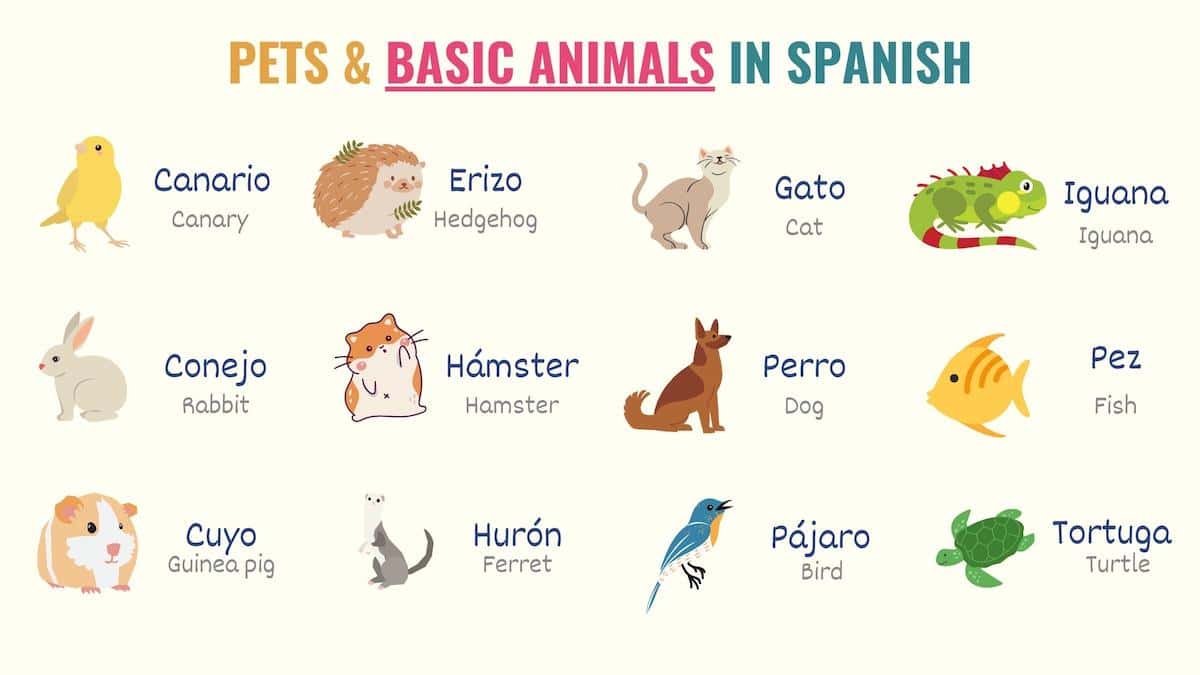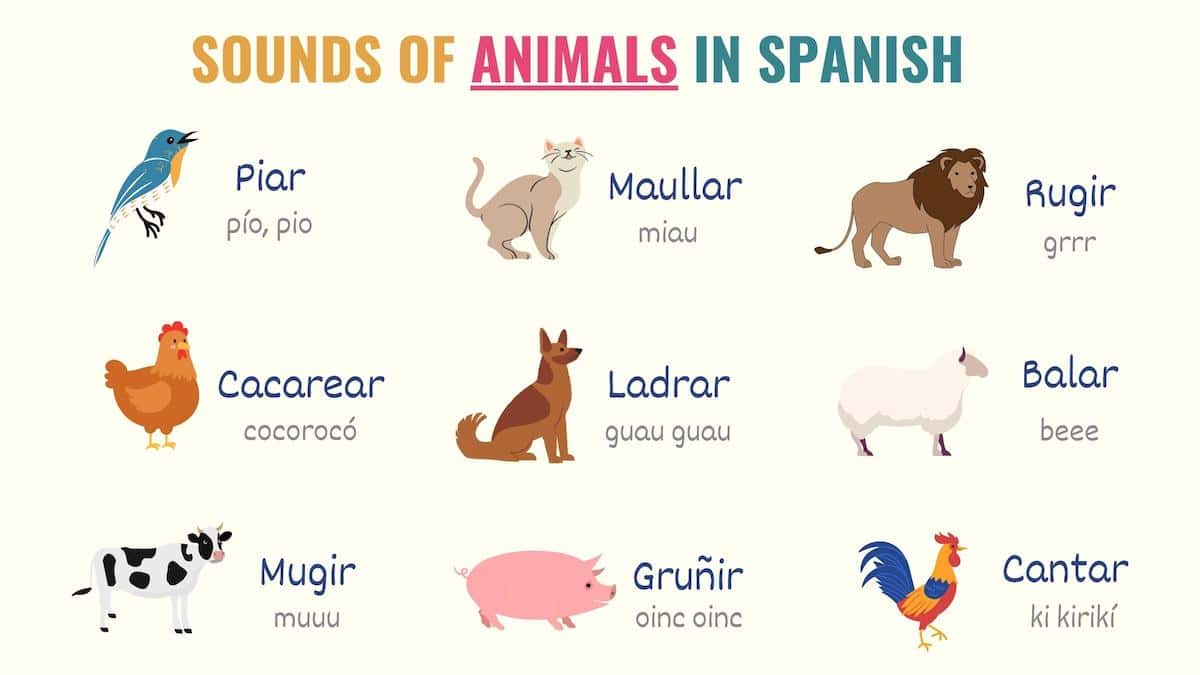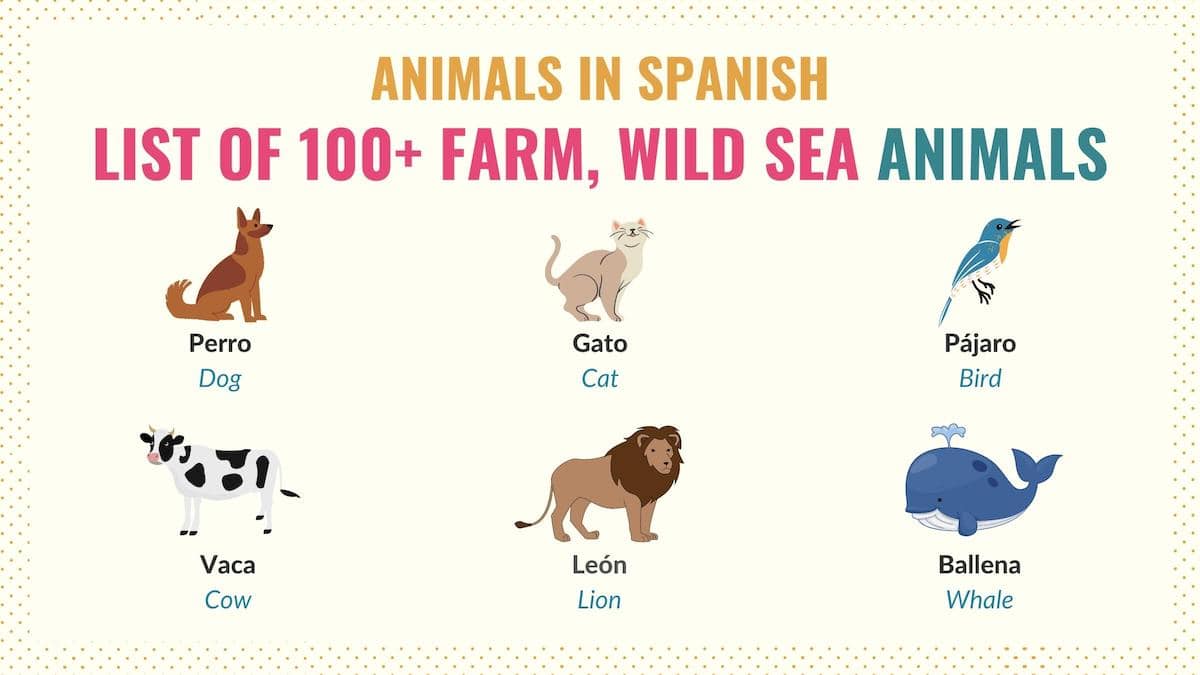Words for animals in Spanish are more useful than you think. We use them to talk about our pets, in idioms, or to describe animals that surround us. In short, these are terms you can apply in daily conversations.
So, in this guide, you’ll find a thorough list of animals in Spanish. Here is an overview of what we’ll learn:
- Lists of Spanish Animals
- Sounds of Animals in Spanish
- Bonus: Spanish Idioms with Animals
- Downloadable PDF
As we go through the various lists of animals in Spanish, I’ll point out which animals have different names for male and female animals, any changes in their plural forms, and important variations you need to know.
Take Note: Words for animals are considered nouns. Nouns are one of the parts of speech in Spanish that change to mark the number and gender of the animal we’re talking about. Check this article to learn more about rules for the gender of nouns in Spanish.
Lists of Spanish Animals
Pets & Basic animals in Spanish

This list of basic animals in Spanish is formed by pets (mascotas). You’ll likely use these words daily, even if you’re not a pet owner.
| Spanish | English |
|---|---|
| Canario | Canary |
| Conejo | Rabbit |
| Cuyo | Guinea pig |
| Erizo | Hedgehog |
| Hámster | Hamster |
| Hurón | Ferret |
| Gato | Cat |
| Iguana | Iguana |
| Loro | Parrot |
| Pájaro | Bird |
| Perico | Parakeet |
| Perro | Dog |
| Pez | Fish |
| Tortuga | Turtle |
Mis peces son muy aburridos.
My fish are very boring.
Mi vecina tiene tres gatos y dos perros.
My neighbor has three cats and two dogs.
Take Note: The plural form of pez is peces. Don’t confuse these words with ‘pescado’ or ‘pescados’. Although they all mean ‘fish’, pescados are what you fished and are likely to be eaten.
Spanish farm animals
Here is a list of common farm animals you can add to your vocabulary list. Notice that some of these animals have different words for females and males.
| Spanish | English |
|---|---|
| Abeja | Bee |
| Buey | Ox |
| Burro / Asno | Donkey |
| Caballo | Horse |
| Cabra | Goat |
| Carnero | Ram |
| Cerdo | Pig |
| Gallina | Hen |
| Gallo | Rooster |
| Macho cabrío | Billy-goat |
| Mula | Mule |
| Oveja | Sheep |
| Vaca | Cow |
| Toro | Bull |
| Yegua | Mare |
Las gallinas ponen huevos.
Hens lay eggs.
Nuestra yegua se llama Bonita.
Our mare is called Bonita.
Hay dos caballos en esa granja.
There are two horses on that farm.
Sea & aquatic animals in Spanish
With the exception of ‘pingüino’, words for sea animals in Spanish do not mark the gender. So, the same term is used for both females and males. If you need to add the gender, you can place the word macho (male) or hembra (female) after the animal name.
Here is a list of common aquatic and sea animals in Spanish:
| Spanish | English |
|---|---|
| Ballena | Whale |
| Ballena azul | Blue whale |
| Ballena jorobada | Humpback whale |
| Calamar | Squid |
| Camarón | Shrimp |
| Delfín | Dolphin |
| Estrella de mar | Starfish |
| Foca | Seal |
| Medusa / Aguamala | Jellyfish |
| Pez | Fish |
| Pez espada | Swordfish |
| Pingüino | Penguin |
| Pulpo | Octopus |
| Orca | Killer whale |
| Tiburón | Shark |
| Tiburón blanco | White shark |
| Tortuga marina | Sea turtle |
Me gustan los pingüinos.
I like penguins.
¿Ese es un delfín macho?
Is that a male dolphin?
Take Note: In Spanish, there are different types of sharks, whales, or fish. As shown in the table above, you can add the subtype term after the main word. For example, pez payaso (clownfish).
Spanish wild animals
Most of the words for wild animals in Spanish are used for female and male animals. However, some words need to be changed to mark gender. In this case, you simply need to add or replace the ‘o’ for an ‘a’.
Examples of words that do mark gender are:
- León / Leona
- Ganso / Gansa
- Lobo / Loba
- Oso / Osa
- Zorro / Zorra
- Pato / Pata
Here is a list of the most common wild animals in Spanish you should know:
| Spanish | English |
|---|---|
| Águila | Eagle |
| Ardilla | Squirrel |
| Avestruz | Ostrich |
| Búho | Owl |
| Buitre | Vulture |
| Camello | Camel |
| Canguro | Kangaroo |
| Castor | Beaver |
| Chita / Guepardo | Cheetah |
| Chimpancé | Chimpanzee |
| Cisne | Swan |
| Cocodrilo | Crocodile |
| Comadreja | Weasel |
| Coyote | Coyote |
| Cuervo | Crow |
| Elefante | Elephant |
| Ganso | Goose |
| Gorila | Gorilla |
| Halcón | Hawk |
| Hiena | Hyena |
| Hipopótamo | Hippopotamus |
| Jabalí | Wild boar |
| Jirafa | Giraffe |
| León | Lion |
| Leopardo | Leopard |
| Lobo | Wolf |
| Llama | Llama |
| Mapache | Racoon |
| Mono / Chango | Monkey |
| Oso | Bear |
| Pato | Duck |
| Pavo | Turkey |
| Puma | Puma |
| Rana | Frog |
| Rata | Rat |
| Ratón | Mouse |
| Rinoceronte | Rhinoceros |
| Sapo | Toad |
| Serpiente | Snake |
| Tigre | Tiger |
| Venado / Ciervo | Deer |
| Zarigüeya | Possum |
| Zebra | Zebra |
| Zorrillo / Mofeta | Skunk |
| Zorro | Fox |
Hay dos venados en la carretera.
There are two deer on the highway.
Los monos son muy traviesos.
Monkeys are very mischievous.
Los leones y los tigres son animales feroces.
Lions and tigers are ferocious animals.
Baby animals in Spanish
Just as is the case in English, often in Spanish, we must use special terms to refer to the offspring of certain animals. Here are some words for baby animals you may want to know:
- Becerro: calf
- Cachorro: puppy / cub
- Cabrito / Chivo: kid (goat)
- Cordero / Borrego: lamb
- Lobezno: wolf cub
- Lechón: piglet
- Osezno: bear cub
- Pollo: chicken
- Potrillo: foal
Although these words are common, you can also use the diminutive form of an animal to refer to baby animals in Spanish. For example, both of the following sentences are correct ways to refer to puppies:
Mi perra tuvo tres cachorros.
My dog had three puppies.
Mi perra tuvo tres perritos.
My dog had three puppies.
Sounds of Animals in Spanish
Here is a graphic with the different sounds of animals in Spanish. The words in blue are verbs – we use them to talk about these sounds. The words in gray are onomatopoeias: they represent the sounds animals make in Spanish.

Los perros de mis vecinos ladran mucho.
My neighbors’ dogs bark a lot.
El gatito maulla cuando tiene hambre.
The kitty meows when he’s hungry.
Take Note: Onomatopoeias are a fun and easy way to teach kids the animals in Spanish.
Bonus: Spanish Idioms with Animals
Spanish idioms with animals are common expressions that help you convey complex ideas in simple words. Here are some examples of these types of idioms:
- Agarrar al toro por los cuernos. – Take the bull by the horns.
- Perro que ladra no muerde. – All bark and no bite.
- Tener memoria de elefante. – To have a good memory.
- Tener pájaros en la cabeza. – Have your head in the clouds.
- A otro perro con ese hueso. – Give me a break.
- Ser un gallina. – To be a coward.
- Ser un gallito / Creerse un gallito. – To think yourself a big shot.
- Lágrimas de cocodrilo. – Crocodile tears.
- Estar más loco que una cabra. – Have bats in the belfry.
¡No seas gallina, vamos!
Don’t be a coward, let’s go!
Mary tiene memoria de elefante, no se le olvida nada.
Mary has such a good memory, she never forgets anything.
Take Note: Idioms and sayings are crucial to sound more natural and fluent in Spanish. You can check my guide on common idioms and popular Spanish sayings to learn more phrases like these.
Download the PDF List of Animals in Spanish
Obviously some of these animal names are more common in daily conversations than others. However, as you continue to expand your vocabulary over time, you’ll need to learn them all to become fluent in Spanish. That’s why I’ve created a free PDF you can download which contains the entire list of animals and any variations in Spanish (such as gender and plural forms) you’ll need.



